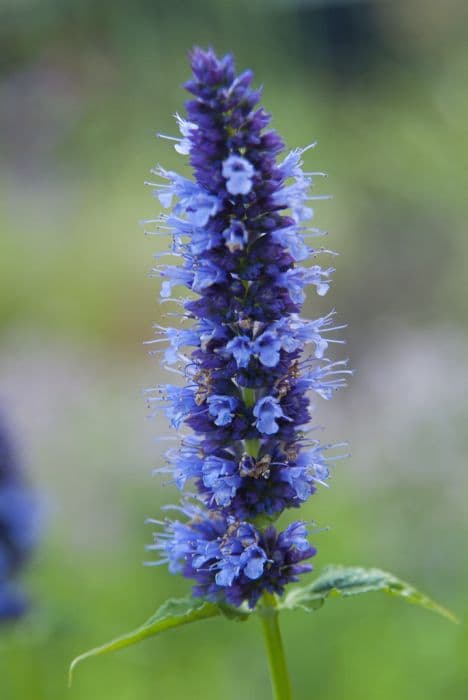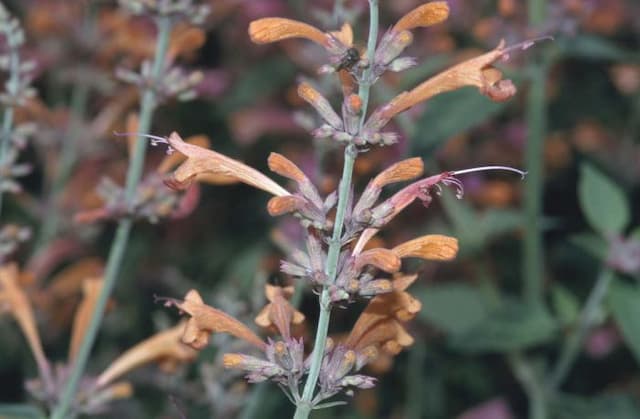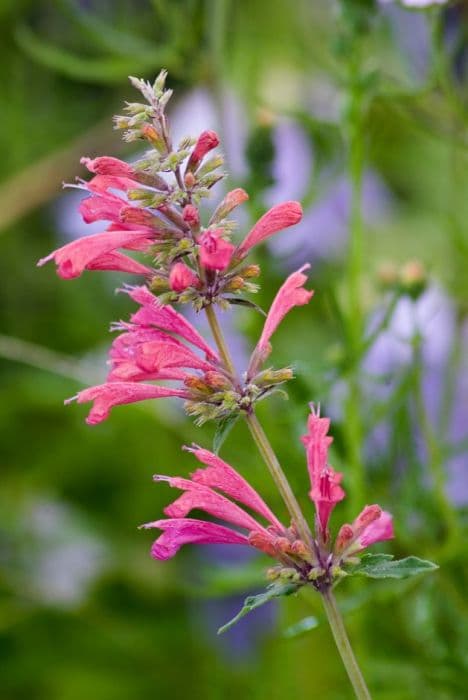Lavender Lavandula × intermedia 'Sussex'

ABOUT
Lavandina × intermedia 'Sussex', commonly known as lavender, is a perennial herb that is widely appreciated for its fragrant and ornamental value. This particular type typically features silvery-green foliage, which is composed of narrow leaves that exude a delightful, aromatic scent when brushed against or crushed. The plant is distinguished by its strikingly beautiful flower spikes that exhibit a profusion of small, tubular blooms. These flowers usually come in shades of purple or violet, which are known to attract bees, butterflies, and other pollinating insects. The flowers are arranged in terminal inflorescences and emerge from slender, upright stems that contrast nicely with the grayish-green of the leaves. The overall appearance of lavender is one of natural elegance and charm, with its calming color palette and signature fragrance that makes it a favorite among gardeners and landscapers.
About this plant
 Names
NamesFamily
Lamiaceae
Synonyms
Sussex Lavender, Lavandin
Common names
Lavandula × intermedia 'Sussex'.
 Toxicity
ToxicityTo humans
Lavender, specifically the Lavandula × intermedia 'Sussex', is generally not considered toxic to humans. Ingesting lavender in small amounts, such as those typically used in cooking or tea, is not harmful. However, consuming large quantities of lavender, especially in the form of essential oils or unprocessed plant parts, may cause nausea, vomiting, and headache. Essential oils should never be ingested due to their high concentration. As with all plants, individual allergies or sensitivities can occur, so some people might experience adverse reactions even to small quantities. Always exercise caution and consult a medical professional if experiencing symptoms after ingesting any plant.
To pets
Lavender, including the Lavandula × intermedia 'Sussex', is generally considered safe for pets, such as dogs and cats, in small amounts. The plant is not listed as toxic by the American Society for the Prevention of Cruelty to Animals (ASPCA). If a pet ingests a large amount of lavender, it might experience gastrointestinal upset, such as vomiting or diarrhea. The essential oil of lavender, due to its concentrated nature, can be harmful if ingested or applied topically to pets, and it should be used with caution around them. If you suspect your pet is experiencing adverse effects after ingesting lavender, contact your veterinarian.
 Characteristics
CharacteristicsLife cycle
Perennials
Foliage type
Evergreen
Color of leaves
Gray-green
Flower color
Lavender
Height
2-3 feet (60-90 cm)
Spread
2-4 feet (60-120 cm)
Plant type
Shrub
Hardiness zones
5-9
Native area
Mediterranean
Benefits
 General Benefits
General Benefits- Aromatic fragrance: Lavandin 'Sussex' emits a pleasing scent which can help to create a calming and relaxing atmosphere in gardens and homes.
- Landscape beauty: It offers aesthetic appeal to any garden with its beautiful purple flowers and silvery-green foliage.
- Attracts pollinators: This hybrid lavender attracts bees, butterflies, and other beneficial insects, supporting local ecosystems.
- Drought resistance: Once established, Lavandin 'Sussex' is quite tolerant of dry conditions, requiring minimal watering.
- Culinary uses: The flowers and leaves can be used to add flavor to a variety of dishes, including baked goods and teas.
- Easy to grow: It's generally easy to cultivate and care for, making it a good choice for novice gardeners.
- Crafting and decoration: Dried flowers are often used in potpourri, bouquets, and other decorative crafts.
 Medical Properties
Medical Properties- Anti-inflammatory: May help reduce inflammation due to certain compounds it contains.
- Antifungal: Can have antifungal properties, potentially useful against certain fungal infections.
- Antiseptic: May have antiseptic qualities, which can assist in cleaning and preventing infection.
- Analgesic: Contains compounds that could soothe and provide relief from pain.
- Anxiolytic: Used in aromatherapy for its calming scent, which might alleviate anxiety and promote relaxation.
- Antispasmodic: May help to relieve muscle spasms and cramps.
 Air-purifying Qualities
Air-purifying QualitiesThis plant is not specifically known for air purifying qualities.
 Other Uses
Other Uses- Lavender can be used to deter moths from closets and drawers by placing dried lavender sachets amongst the clothes.
- When added to compost, lavender can help reduce odors and accelerate the breakdown of materials due to its antiseptic properties.
- Dried lavender can be used to make a natural insect repellant spray for plants by steeping it in water and spraying it onto the leaves.
- Used in crafting, lavender can be incorporated into wreaths, floral arrangements, or potpourri for its scent and aesthetic appeal.
- A few drops of lavender oil can be added to paint to help reduce the odorous fumes during home renovations.
- Lavender can be sewn into eye masks or pillows to promote a more restful sleep due to its relaxing scent.
- In photography, lavender fields are a popular subject due to their vibrant color and the visual appeal of their neat rows.
- As a flavoring agent, lavender can be infused into syrups or sugars for use in culinary dishes and beverages.
- Lavender can be planted in gardens not only for its beauty but to attract pollinators such as bees and butterflies to other plants.
- Crafted into a natural broom, dried lavender stems can be used to gently sweep and freshen the air of indoor spaces.
Interesting Facts
 Feng Shui
Feng ShuiLavender is used in Feng Shui to bring a sense of calm and cleanliness to an environment, which can aid in reducing stress and promoting relaxation. It is often recommended to place lavender in the living room or bedroom to help soothe and calm the energy of these spaces.
 Zodiac Sign Compitability
Zodiac Sign CompitabilityLavender is not used in astrology practice.
 Plant Symbolism
Plant Symbolism- Peace and Tranquility: Lavender is often associated with a calming effect, which can bring peace to the mind and spirit.
- Purity: The clean and fresh scent of lavender is symbolically linked to purity and cleanliness.
- Serenity: Lavender's ability to promote relaxation and calmness associates it with a serene atmosphere.
- Protection: Lavender is believed to ward off evil spirits or negative energies, offering protection.
- Healing: Historically, lavender has been used in medicinal remedies, symbolizing healing and restoration of health.
- Love: Its enchanting fragrance and beauty can also symbolize love and devotion.
 Water
WaterLavender (most common common name for Lavandula × intermedia 'Sussex') is drought-tolerant once established and prefers a less-is-more approach to watering. Water young plants every other day until they're established during the first growing season. Thereafter, provide about a gallon of water every two to three weeks during the growing season if there has been no significant rainfall. Adjust this schedule during hot, dry periods by providing additional water, but always allow the soil to dry out between waterings to prevent root rot. It's important not to overwater lavender, as it thrives in dry conditions.
 Light
LightLavender performs best in full sunlight conditions, requiring at least six to eight hours of direct sun per day. The ideal spot for lavender is in an area where it will receive long hours of sunlight while being protected from harsh, late afternoon sun if possible. If you're planting indoors, a south-facing window is usually the best location to provide the ample light lavender needs to flourish.
 Temperature
TemperatureLavender thrives in a wide range of temperatures but prefers a moderate climate. The plant is hardy and can survive in temperatures as low as 20 degrees Fahrenheit but can be damaged by temperatures below this threshold. Ideally, lavender enjoys daytime temperatures ranging from 70 to 80 degrees Fahrenheit. To ensure healthy growth, protect the plant from extreme cold by providing insulation during frosts or considering container planting for easy movement.
 Pruning
PruningPruning lavender promotes fresh growth and prevents the plant from becoming woody and sparse. It's best to prune lavender in the spring just as new growth appears or immediately after flowering. For Lavandula × intermedia 'Sussex', prune annually, cutting back by about one-third to one-half, avoiding cutting into the old wood. The best time for pruning is typically after the first flush of flowers has faded but before the fall to allow for ample time for regrowth before winter sets in.
 Cleaning
CleaningAs needed
 Soil
SoilThe best soil mix for Lavender (Lavandula × intermedia 'Sussex') is well-draining with a neutral to slightly alkaline pH between 6.7 and 7.3. A mixture of coarse sand, peat, and compost with some gravel at the bottom for improved drainage is ideal.
 Repotting
RepottingLavender (Lavandula × intermedia 'Sussex') generally needs repotting every one to two years to prevent it from becoming root-bound and to replenish nutrient-rich soil.
 Humidity & Misting
Humidity & MistingLavender (Lavandula × intermedia 'Sussex') prefers dry conditions and does well with low to moderate humidity levels, mimicking its natural Mediterranean habitat.
 Suitable locations
Suitable locationsIndoor
Place in sunny spot, water sparingly, ensure good air flow.
Outdoor
Full sun, well-drained soil, space plants apart.
Hardiness zone
5-9 USDA
 Life cycle
Life cycleLavandula × intermedia 'Sussex', commonly known as Sussex Lavender, starts its life cycle as a seed, which germinates in warm, well-drained soil, usually in late spring or early summer. As a seedling, it establishes a root system and grows a rosette of leaves at ground level, gradually maturing into a woody perennial plant. The lavender enters a vegetative phase, developing gray-green foliage and woody stems, during which it grows steadily in favorable conditions of full sun and low to moderate moisture. In late spring to early summer of the following year, the plant produces tall, erect flower spikes with highly aromatic, purple flowers that are attractive to bees and other pollinators. After flowering, the plant can be pruned to promote bushier growth and to prevent it from becoming leggy. Finally, Sussex Lavender is a perennial, so after the flowers fade and the plant enters dormancy in winter, it will rest before beginning the cycle again with new growth in the spring.
 Propogation
PropogationPropogation time
Early spring
The most popular method of propagation for Lavandula × intermedia 'Sussex', commonly known as Lavandin or Hybrid Lavender, is through semi-hardwood cuttings. This typically occurs during summer when the new growth has partially matured. One starts by selecting healthy, non-flowering stems and cuts a 3 to 4 inch (about 8 to 10 cm) length, making the cut just below a node. The lower leaves are then stripped off, and the base of the cutting can be dipped in rooting hormone powder to enhance root development. The prepared cutting is then placed in a well-draining potting mix or a mixture of peat and perlite, ensuring the nodes where the leaves were removed are buried. The pot needs to be kept in a warm, well-lit area but out of direct sunlight, and the soil should be kept moist but not soggy. With proper care, roots will form within a few weeks, after which the new Lavandin plants can be transplanted to their final growing locations.






![Bugle [Sugar Plum]](/_next/image?url=https%3A%2F%2Fplants-admin.emdemapps.com%2Fimages%2Fplants%2F%2Fimages%2F604b597956a55.png&w=640&q=75)
![Bugle [Princess Nadia]](/_next/image?url=https%3A%2F%2Fplants-admin.emdemapps.com%2Fimages%2Fplants%2F%2Fimages%2F604b5806e268c.png&w=640&q=75)

